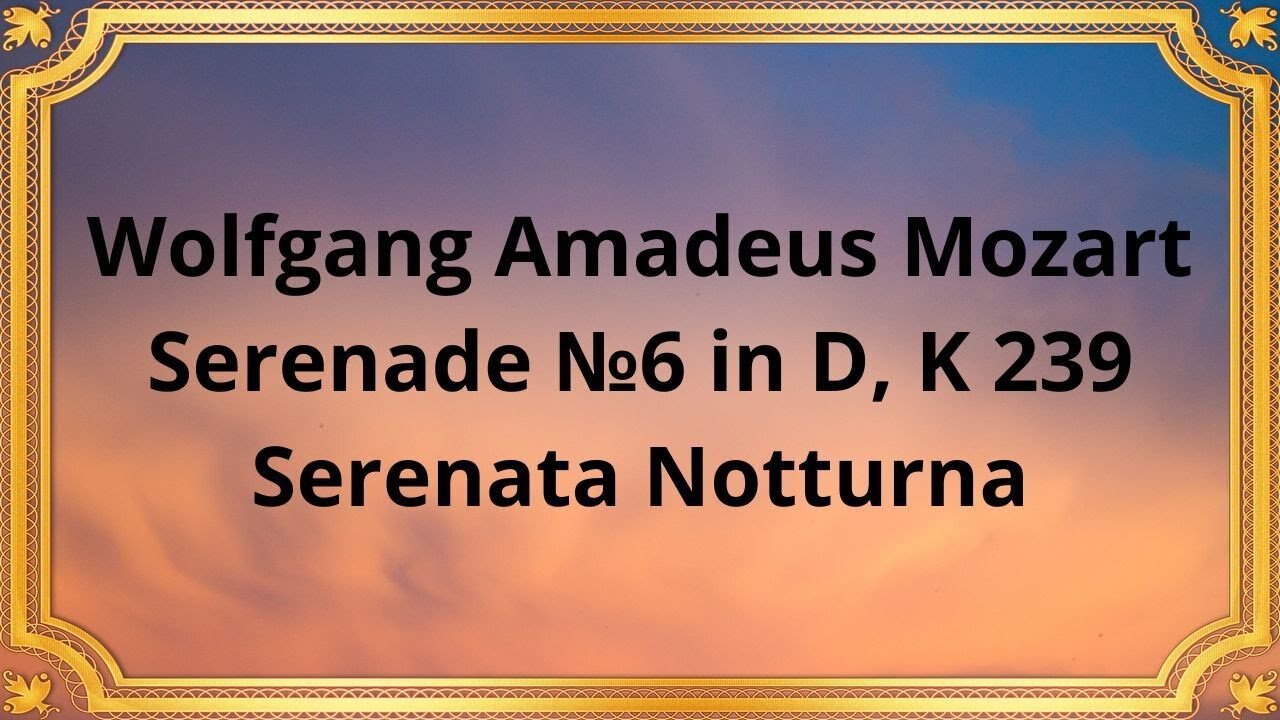Premium Only Content

Wolfgang Amadeus Mozart Serenade №6 in D, K 239 Serenata Notturna
Publication date 1946
Vox Chamber Orchestra conducted by Edvard Fendler
Mozart's Serenade No. 6 in D, K 239, also known as the Serenata Notturna, is a captivating piece of music that has stood the test of time. Written in 1776, the serenade is a masterpiece of classical music that features a unique blend of lively melodies, intricate harmonies, and technical virtuosity.
The Serenata Notturna is structured in four movements, each with its distinct character and mood. The first movement is a lively march, followed by a slower and more lyrical second movement. The third movement is marked by a brief and playful trio, and the final movement brings the piece to a joyous and exuberant conclusion.
Mozart's use of harmony and melody in the Serenata Notturna is remarkable, showcasing his unique style and creativity. The piece is written in D major, a bright and uplifting key that perfectly suits the serenade's cheerful and festive mood. The melodies are lively and memorable, ranging from simple and elegant to complex and virtuosic. Mozart employs a range of harmonic techniques, creating a rich and diverse sound world.
The serenade's technical demands are considerable, particularly for the soloists. The piece requires a high level of technical proficiency, including rapid finger work, challenging bowing techniques, and complex musical phrasing. Mozart's writing for the soloists is highly virtuosic, showcasing their full range of expressive possibilities.
Mozart's Serenade No. 6 in D, K 239, has had a significant impact on the development of the serenade genre. Its technical demands and expressive depth have inspired generations of musicians, from classical composers like Brahms and Tchaikovsky to modern-day artists like John Williams. The piece remains a popular and frequently performed work to this day, a testament to Mozart's enduring legacy as one of the greatest composers in history.
Conclusion:
Mozart's Serenade No. 6 in D, K 239, is a masterpiece of musical composition, showcasing the composer's exceptional talent and skill. Its beautiful harmonies, intricate melodies, and technical demands make it a favorite of audiences and musicians alike. As a cornerstone of the serenade genre, the Serenata Notturna remains a vital and influential work in the classical music canon, continuing to inspire and move audiences over two centuries after its creation.
-
 23:19
23:19
Classical music_Music Inspiration
2 days agoLudwig van Beethoven Sonata No. 23 in F minor, Op. 57 "Appassionata"
121 -
 56:48
56:48
The HotSeat
12 hours agoI'm NOT Sorry! Guns Aren’t the Problem—Godless Culture Is
26.1K29 -
 9:43
9:43
The Pascal Show
13 hours ago $0.05 earnedWHOA! Annunciation School Sh**ter Identified... Heartbreaking & Insane
1122 -
 22:42
22:42
Liberty Hangout
8 hours agoCollege Democrats Say Gangs Are GOOD!
47.3K60 -
 2:14:50
2:14:50
Badlands Media
13 hours agoBadlands Media Fantasy Football Live Draft
40.2K -
 2:12:29
2:12:29
Inverted World Live
7 hours agoWe Are Time Travelers | Ep. 100
79.8K13 -
 2:57:09
2:57:09
TimcastIRL
7 hours agoCorporate Press Refuses To Mention Minneapolis Shooter Was Trans | Timcast IRL
187K101 -
 5:26:57
5:26:57
Akademiks
6 hours agoWar in RAT-LANTA. Young Thug vs Gunna vs Ralo vs YSL MONDO. Who Will Le Bebe Pick. FINAL CRASHOUT!
54.5K4 -
 1:02:24
1:02:24
Man in America
10 hours agoThe Final Battle: Nanotech, Transhumanism & the War for Your Soul w/ Dr. Ed Group
44.8K6 -
 39:56
39:56
Sarah Westall
5 hours agoUpcoming World Wide Economic Collapse/Deep Recession & What the Big Money is Doing w/ Ed Dowd
41.2K5